1996 CHEVROLET BLAZER automatic transmission
[x] Cancel search: automatic transmissionPage 233 of 392
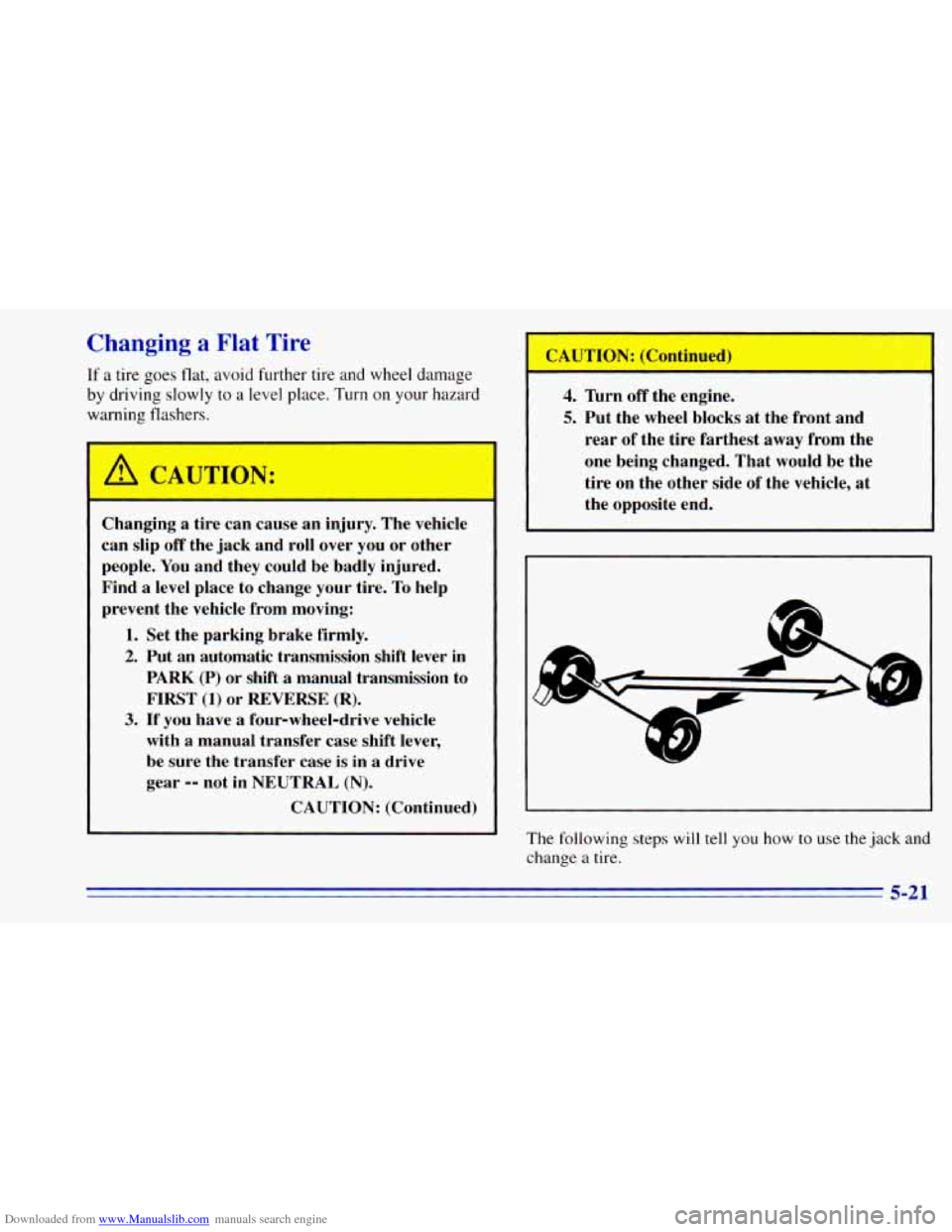
Downloaded from www.Manualslib.com manuals search engine Changing a Flat Tire
If a tire goes flat, avoid further tire and wheel damage
by driving slowly to a level place. Turn on your hazard
warning flashers.
Changing
a tire can cause an injury. The vehicle
can slip
off the jack and roll over you or other
people. You and they could be badly injured.
Find
a level place to change your tire. To help
prevent the vehicle from moving:
1. Set the parking brake firmly.
2. Put an automatic transmission shift lever in
PARK (P) or shift
a manual transmission to
FIRST (1)
or REVERSE (R).
3. If you have a four-wheel-drive vehicle
with
a manual transfer case shift lever,
be sure the transfer case is in
a drive
gear
-- not in NEUTRAL (N).
CAUTION: (Continued) CAUTION: (Continued)
4. Turn off the
engine.
5. Put the wheel blocks at the front and
rear of the tire farthest away from the
one being changed. That would be the
tire on the other side of the vehicle,
at
the opposite end.
The following steps will tell
you how to use the jack and
change a tire.
5-21
Page 262 of 392
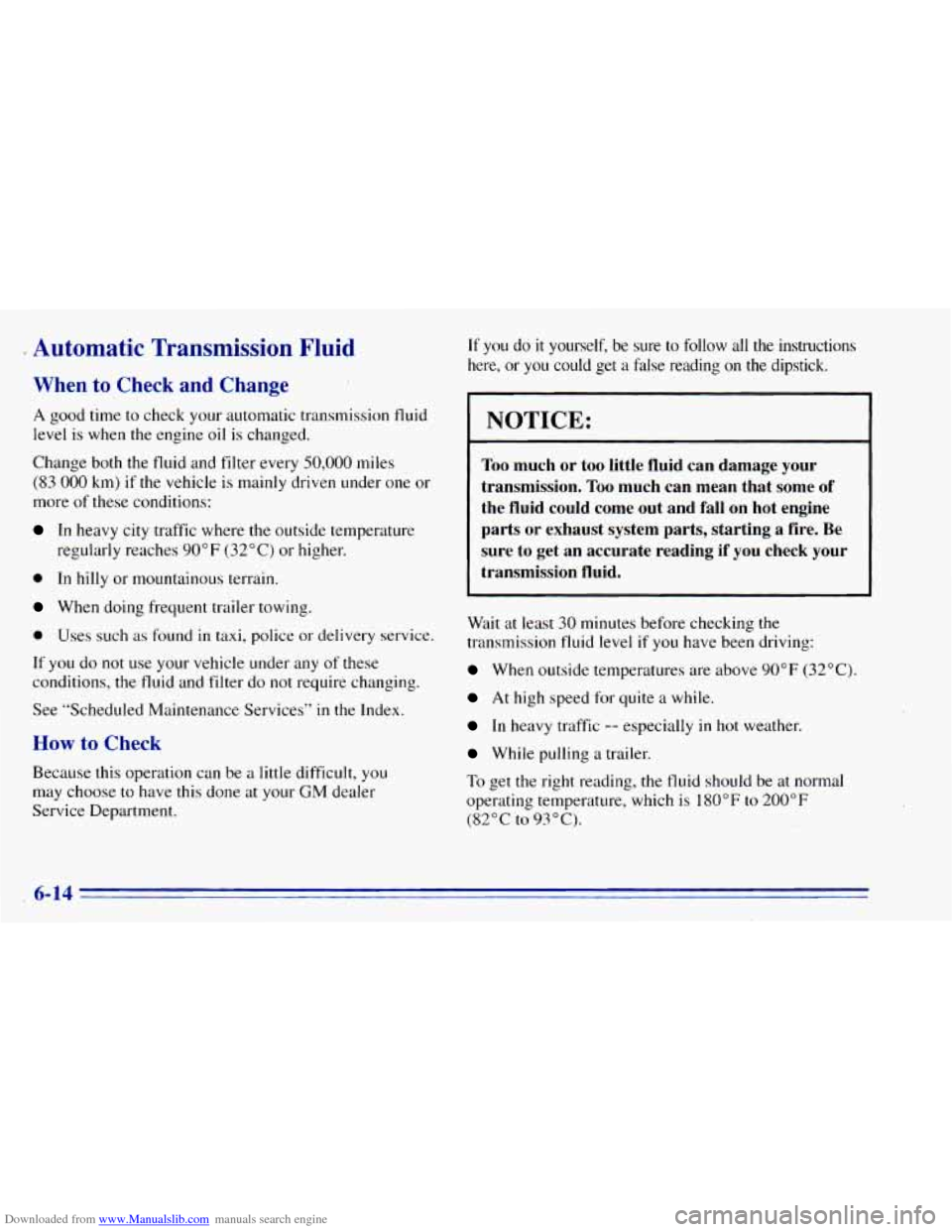
Downloaded from www.Manualslib.com manuals search engine .. Automatic Transmission Fluid
When to Check and Change
A good time to check your automatic transmission fluid
level
is when the engine oil is changed.
Change both
the fluid and filter every 50,000 miles
(83 000 km) if the vehicle is mainly driven under one or
more
of these conditions:
In heavy city traffic where the outside temperature
regularly reaches
90°F (32°C) or higher.
0 In hilly or mountainous terrain.
When doing frequent trailer towing.
0 Uses such as found in taxi, police or delivery service.
If you do not use your vehicle under any of these
conditions, the fluid and filter
do not require changing.
See “Scheduled Maintenance Services” in the Index.
How to Check
Because this operation can be a little difficult, you
may choose to have this done at your GM dealer
Service Department.
If you do it yourself, be sure to follow all the instructions
here, or you could get
a false reading on the dipstick.
I NOTICE:
Too much or too little fluid can damage your
transmission.
Too much can mean that some of
the fluid could come out and fall on hot engine
parts or exhaust system parts, starting a fire. Be
sure to get an accurate reading if you check your
transmission fluid.
Wait at least 30 minutes before checking the
transmission fluid level
if you have been driving:
When outside temperatures are above 90°F (32°C).
At high speed for quite a while.
In heavy traffic -- especially in hot weather.
While pulling a trailer.
To get the right reading, the fluid should be at normal
operating temperature, which is
180°F to 200°F
(82°C to 93°C).
. 6-14
Page 264 of 392
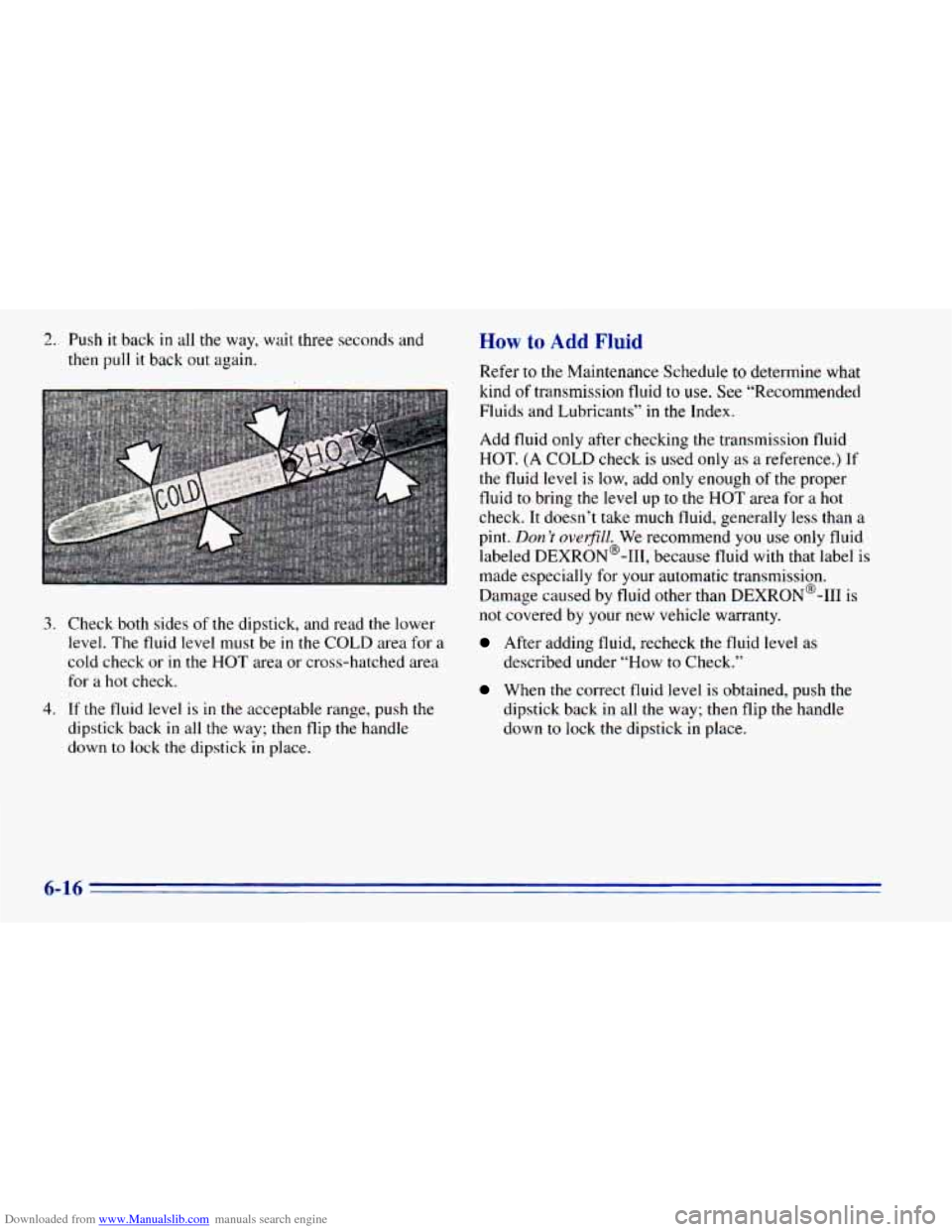
Downloaded from www.Manualslib.com manuals search engine 2. Push it back in all the way, wait three seconds and
then
pull it back out again,
3. Check both sides of the dipstick, and read the lower
level. The fluid level must be in the COLD area for a
cold check or in the HOT area or cross-hatched area
for a hot check.
4. If the fluid level is in the acceptable range, push the
dipstick back in all
the way; then flip the handle
down
to lock the dipstick in place.
How to Add Fluid
Refer to the Maintenance Schedule to determine what
kind
of transmission fluid to use. See “Recommended
Fluids and Lubricants”
in the Index.
Add fluid only after checking the transmission fluid
HOT. (A COLD check is used only as
a reference.) If
the fluid level is low, add only enough
of the proper
fluid to bring the level up
to the HOT area for a hot
check. It doesn’t take much fluid, generally less than a
pint. Don ’t overfill. We recommend you use only fluid
labeled DEXR0N’-111, because fluid with that label is
made especially
for your automatic transmission.
Damage caused by fluid other than DEXRON@-I11 is
not covered by your new vehicle warranty.
After adding fluid, recheck the fluid level as
described under “How to Check.”
When the correct fluid level is obtained, push the
dipstick back in all the way; then flip the handle
down to lock the dipstick in place.
Page 309 of 392

Downloaded from www.Manualslib.com manuals search engine FuseKircuit Usage
Breaker
5
7
8
9
10
11
Oxygen Sensor Heater, Exhaust Gas
Recirculation, Cam Sensor, CANN.
Purge, MAS
Blower Motor, Temperature Door
Motor, HI Blower Relay Coil
Power Auxiliary Outlets, Assembly
Line Diagnostic Link
Rear Window Defogger
PCMNCM Battery, ABS Battery
PCMNCM Ignition, Injectors, Crank
Sensor, Coil Driver Module
Radio, Inside Rearview Mirror Map
Lamp, Overhead Console Reading
Lamps, Rear Wiper, Rear Washer,
Overhead Console Display
12 DRAC, Anti-Lock Braking System, VCM IGN-3
13
14
Clock, Radio, Battery, CD Player
A/C Compressor Battery Feed
FuseKircuit Usage
Breaker
15
16
17
19
20
21
22 24 Daytime Running Lamps,
Fog Lamps,
Fog Lamp Relay
Turn Signals and Back-up Lamps,
Brake-Transmission Shift Interlock
Solenoid
Windshield Washer, Windshield
Wiper Motor
Electric Shift Transfer Case
Crank Signal, Air Bag System
Cluster Illumination, Radio
Illumination, Heater Lamp, Four-Wheel-Drive Illumination,
Chime Module, Fog Lamp
Illumination, Rear Wiper Switch, Rear
Defog Switch Illumination, Liftglass
Release Switch Illumination,
Overhead Console Illumination
Air Bag System
PRNDL Power, 4L60E Automatic
Transmission
6-61
Page 311 of 392
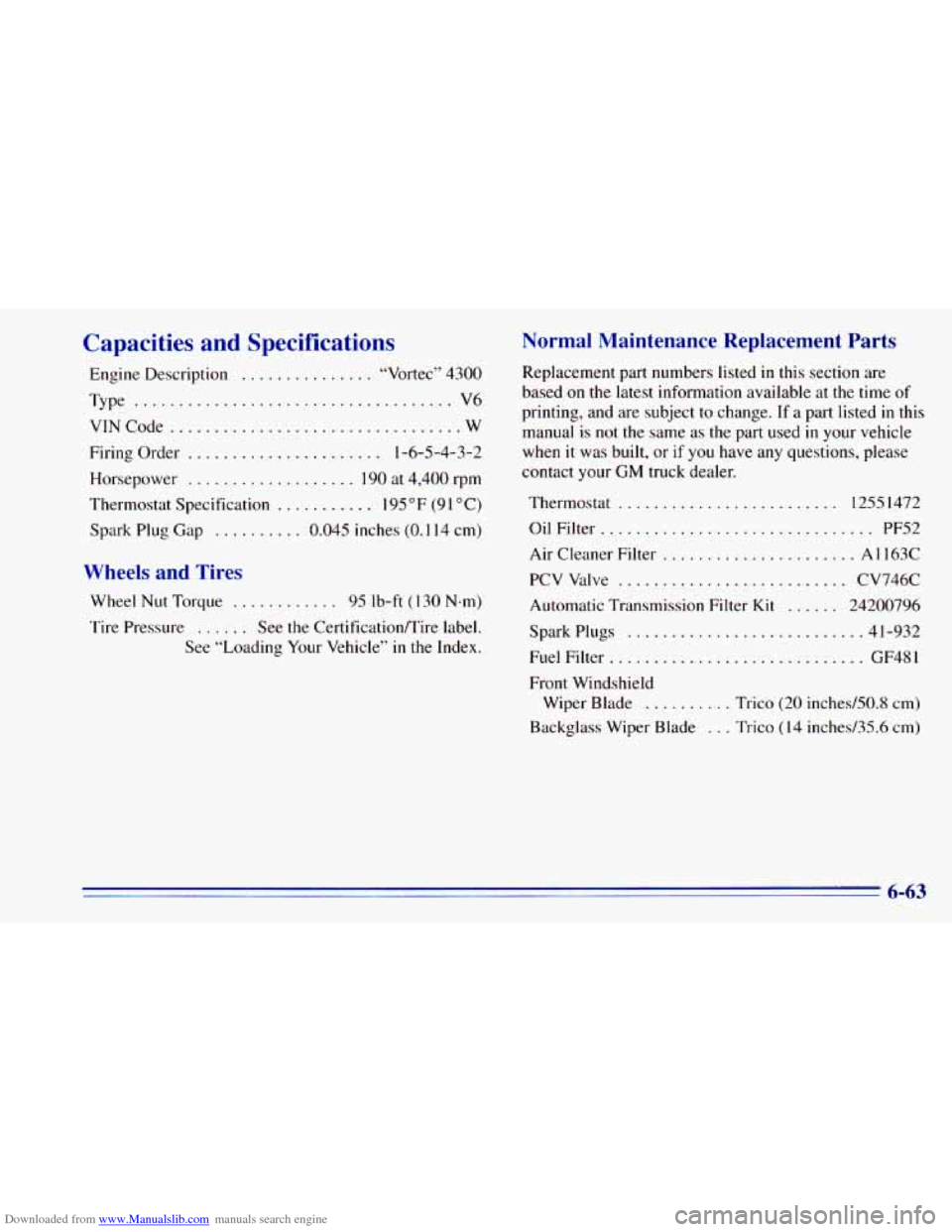
Downloaded from www.Manualslib.com manuals search engine Capacities and Specifications
Engine Description ............... “Vortec” 4300
Type
.................................... V6
VINCode
................................. W
Firing Order ...................... 1-6-5-4-3-2
Horsepower
................... 190 at 4,400 rpm
Thermostat Specification
........... 195°F (91°C)
Spark Plug Gap
.......... 0.045 inches (0.1 14 cm)
Wheels and Tires
Wheel Nut Torque ............ 95 ib-ft (130 N-m)
Tire Pressure ...... See the Certificationmire label.
See “Loading Your Vehicle”
in the Index.
Normal Maintenance Replacement Parts
Replacement part numbers listed in this section are
based on the latest information available at the time of
printing, and are subject to change.
If a part listed in this
manual is not the same as the part used
in your vehicle
when
it was built, or if you have any questions, please
contact your GM truck dealer.
Thermostat
... ... ......... 12551472
Oil Filter..
............................. PF52
Air Cleaner Filter .................. A 1 163C
PCV Valve
.......................... CV746C
Automatic Transmission Filter Kit
...... 24200796
Spark Plugs
.......................... .41-932
Fuel Filter
............................. GF48 1
Front Windshield
Wiper Blade
........ Trico (20 inched50.8 cm)
Backglass Wiper Blade
... Trico (14 inched35.6 cm)
6-63
Page 312 of 392
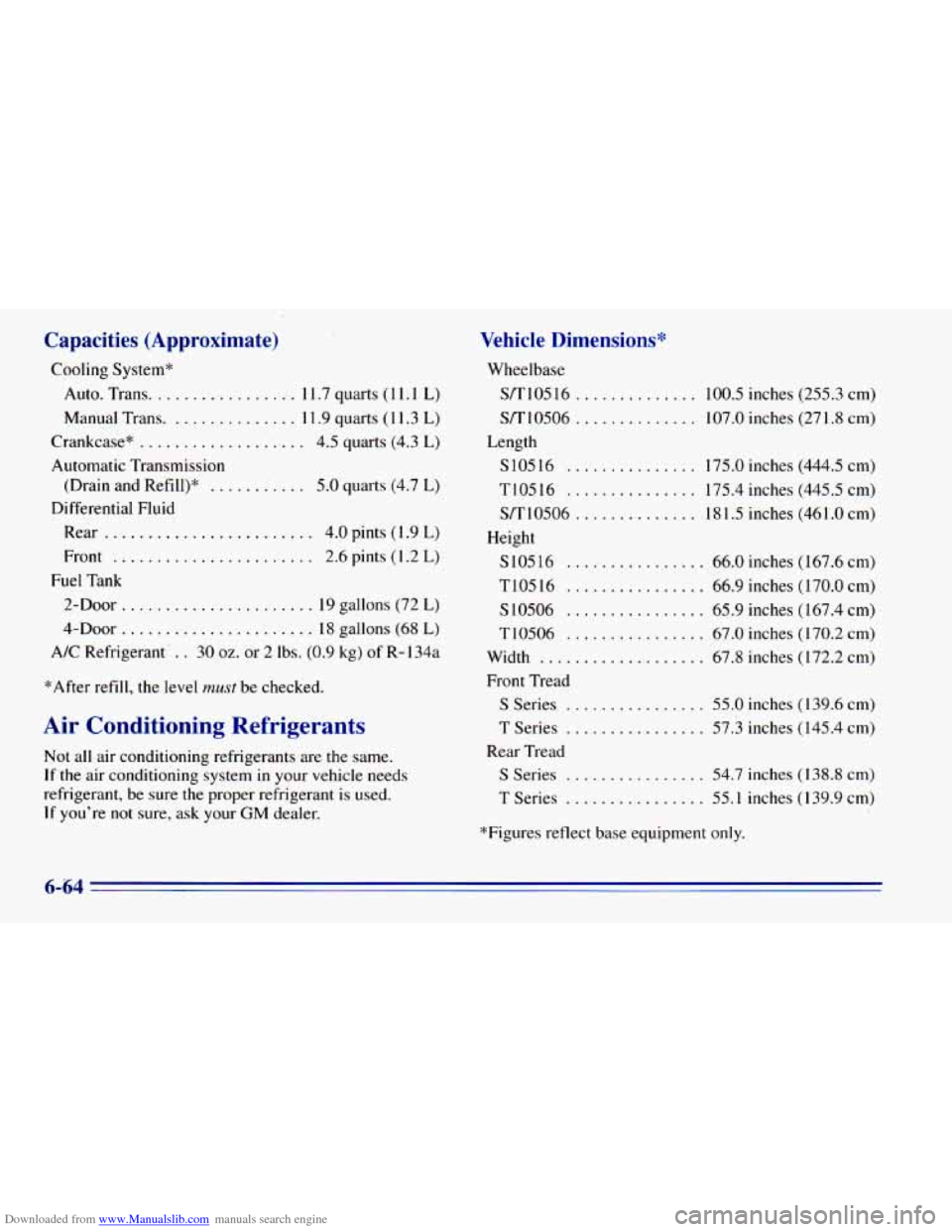
Downloaded from www.Manualslib.com manuals search engine Capacities (Approximate)
Cooling System"
Auto. Trans.
................ 11.7 quarts (1 1.1 L)
Manual Trans. .............. 11.9 quarts (1 1.3 L)
Crankcase*
................... 4.5 quarts (4.3 L)
Automatic Transmission
(Drain and Refill)*
........... 5.0 quarts (4.7 L)
Differential Fluid
Rear
...........
Front ............ ....... 2.6 pints (1.2 L)
2-Door.. .................... 19 gallons (72 L)
4-Door.. .................... 18 gallons (68 L)
A/C Refrigerant. .. 30 oz. or 2 Ibs. (0.9 kg) of R- 134a
Fuel Tank
*After refill, the level
must be checked.
Air Conditioning Refrigerants
Not all air conditioning refrigerants are the same.
If the air conditioning system in your vehicle needs
refrigerant, be sure the proper refrigerant is used.
Jf you're not sure, ask your GM dealer.
Vehicle Dimensions*
Wheelbase
Sl"10516
.............. 100.5 inches (255.3 cm)
Sl"10506
............ 107.0 inches (271.8 cm)
S10516
............. 175.0 inches (444.5 cm)
TI0516
............... 175.4 inches (445.5 cm)
S/T10506
.............. ,181.5 inches (461.0 cm)
Length
Height S10516
....... ..... 66.0 inches (167.6 cm)
T10516
..... ... 66.9 inches (170.0 cm)
S 10506 ............ 65.9 inches (167.4 cm)
T10506
................ 67.0 inches (170.2 cm)
Width
................... 67.8 inches (172.2 cm)
Front Tread
S Series ................ 55.0 inches (139.6 cm)
T Series
................ 57.3 inches (145.4 cm)
Rear Tread
S Series ................ 54.7 inches (138.8 cm)
T Series
................ 55.1 inches (139.9 cm)
*Figures reflect base equipment only.
6-64
Page 316 of 392
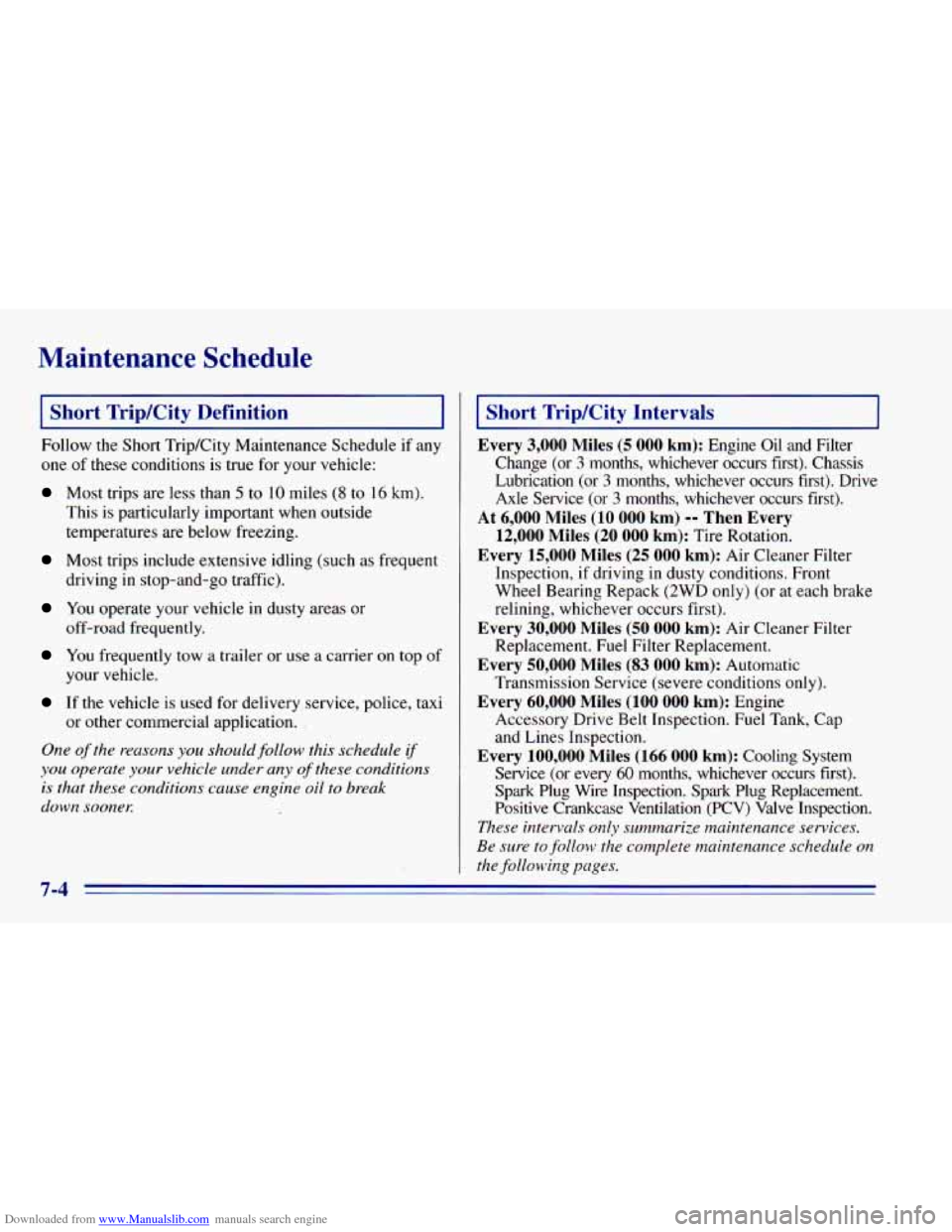
Downloaded from www.Manualslib.com manuals search engine Maintenance Schedule
I Short TripKity Definition
Follow the Short TripKity Maintenance Schedule if any
one
of these conditions is true for your vehicle:
Most trips are less than 5 to 10 miles (8 to 16 km).
This
is particularly important when outside
temperatures are below freezing.
Most trips include extensive idling (such as frequent
driving
in stop-and-go traffic).
You operate your vehicle in dusty areas or
off-road frequently.
You frequently tow a trailer or use a carrier on top of
If the vehicle is used for delivery service, police, taxi
your vehicle.
or other
commercial application.
One of the reasons you should follow this schedule if
you operate your vehicle under any of these conditions
is that these conditions cause engine
oil to break
down
soonex
Short Trip/City Intervals
Every 3,000 Miles (5 000 km): Engine Oil and Filter
Change (or
3 months, whichever occurs first). Chassis
Lubrication (or
3 months, whichever occurs first). Drive
Axle Service (or
3 months, whichever occurs first).
At 6,000 Miles (10 000 km) -- Then Every
12,000 Miles
(20 000 km): Tire Rotation.
Every 15,000 Miles (25 000 km): Air Cleaner Filter
Inspection, if driving in dusty conditions. Front
Wheel Bearing Repack (2WD only) (or at each brake
relining, whichever occurs first).
Every 30,000 Miles (50 000 km): Air Cleaner Filter
Replacement. Fuel Filter Replacement.
Every 50,000 Miles (83 000 km): Automatic
Transmission Service (severe conditions
only).
Every 60,000 Miles (100 000 km): Engine
Accessory Drive Belt Inspection.
Fuel Tank, Cap
and Lines Inspection.
Every 100,000 Miles (166 000 km): Cooling System
Service (or every
60 months, whichever occurs first).
Spark Plug Wire Inspection. Spark Plug Replacement.
Positive Crankcase Ventilation (PCV) Valve Inspection.
These intervals only summarize maintenance services.
Be sure to follow the complete maintenance schedule
on
the following pages.
7-4
Page 317 of 392
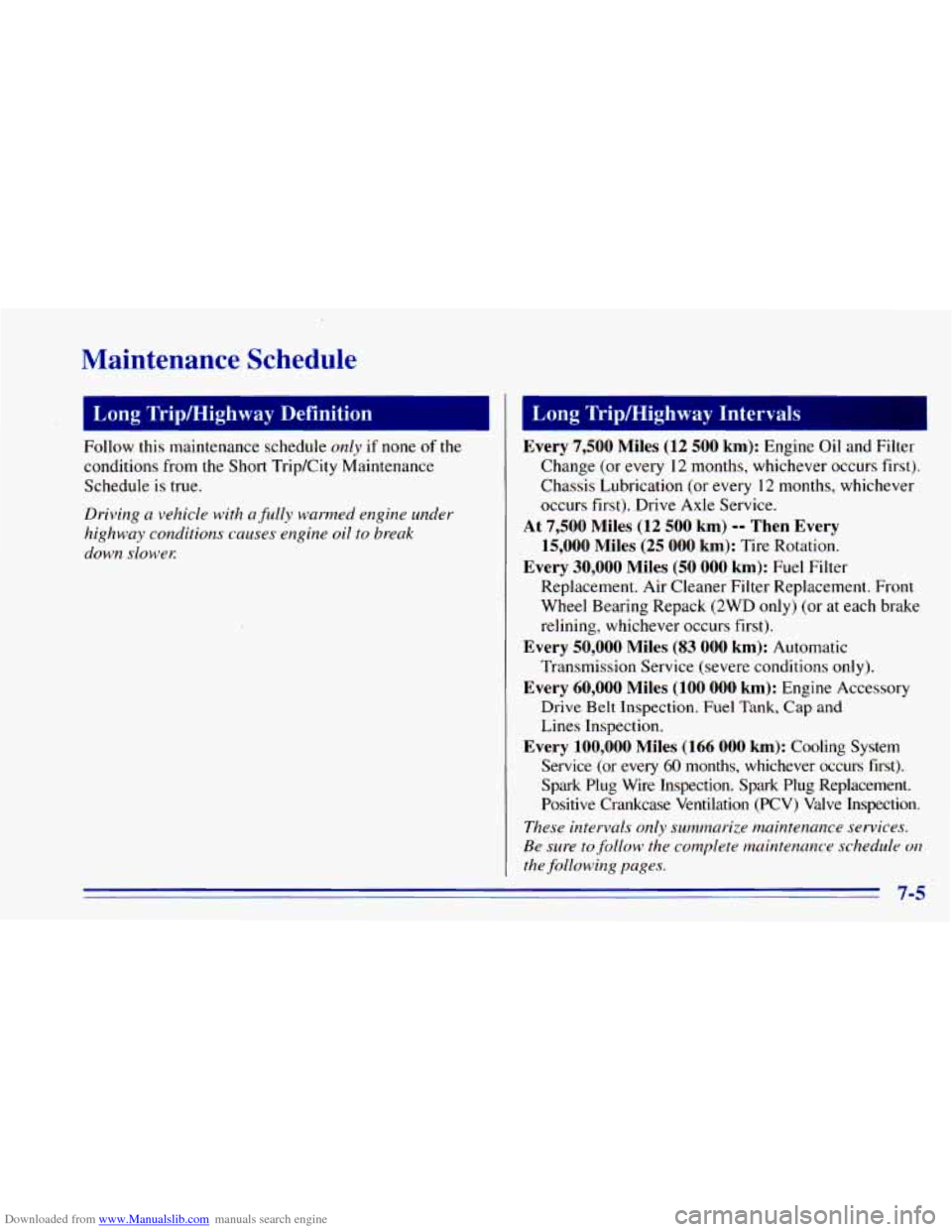
Downloaded from www.Manualslib.com manuals search engine Maintenance Schedule
1 Long TripMighway Definition
Follow this maintenance schedule only ir none of the
conditions from the Short Trip/City Maintenance
Schedule is true.
Driving a vehicle with a fully warmed engine under
highway conditions causes engine oil to break
down slower:
Every 7,500 Miles (12 500 km): Engine Oil and rllter
Change (or every
12 months, whichever occurs first).
Chassis Lubrication (or every 12 months, whichever
occurs first). Drive Axle Service.
At 7,500 Miles (12 500 km) -- Then Every
15,000 Miles
(25 000 km): Tire Rotation.
Every 30,000 Miles (50 000 km): Fuel Filter
Replacement. Air Cleaner Filter Replacement. Front
Wheel Bearing Repack (2WD
only) (or at each brake
relining, whichever occurs first).
Transmission Service (severe conditions only).
Drive Belt Inspection.
Fuel Tank, Cap and
Lines Inspection.
Every 100,000 Miles (166 000 km): Cooling System
Service
(or every 60 months, whichever occurs first).
Spark Plug Wire Inspection. Spark Plug Replacement.
Positive Crankcase Ventilation (PCV) Valve Inspection.
Every 50,000 Miles (83 000 km): Automatic
Every 60,000 Miles (100 000 km): Engine Accessory
These intervals only summarize maintenance services.
Be sure to follow the complete maintenance schedule otl
the following pages.
7-5